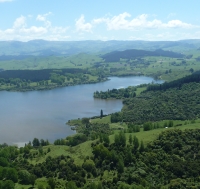I want to...
Current filter: Most popular
A to Z
Apply for a job
Biosecurity
Consents
Consultation
Contact Us
Environmental Data
Farmers Hub
Fix it or Report it
Information Request
Join an Event
Leasehold Land
Meetings
Rates
Water Metering
Have Your Say
Tūtira Restoration Options Presented
Published: 1 December 2016

Scientific modelling of Lake Tūtira has not only given Hawke’s Bay Regional Council a better understanding of how the lake works, it has also highlighted some options for improving water quality and reducing algal blooms.
Chris McBride from University of Waikato has presented the findings of a two-year computer modelling project to the Regional Planning Committee at Hawke’s Bay Regional Council.
As well as showing the conditions when algal blooms form, the modelling includes an assessment of possible solutions for the regular algal blooms and water quality issues in the lake.
“We have much more robust data on water quality and how the algal blooms in the lake occur thanks to the computer model, and the table top assessment of the impact of various options, including reconnection of Papakiri Stream, lake aeration, use of chemical settling agents (flocculants), and reducing the nutrient load. These give us some strong leads on ways forward,” says HBRC Environmental scientist, Dr Andy Hicks.
Chris McBride works under Professor David Hamilton, BOP Regional Council Chair in Lake Restoration at the University of Waikato. Chris has 10 years’ experience with modelling lake water quality and has done extensive work modelling for remediation of the Rotorua Lakes. He also constructed the water monitoring buoy in Lake Tūtira and has several others in lakes around the country and internationally.
The modelling period for Tūtira started in 2010 and used 6 years of water quality data collected from streams in the catchment (including Papakiri Stream), lake water samples, and measurements from the lake buoy. Twenty-five management scenarios were modelled.
The modelling shows that algal blooms in Lake Tūtira are affected by fresh supplies of phosphorus-carrying sediment coming into the lake after heavy rainfall, with substantial contributions from occasional overflows of the Papakiri Stream at the stopbank at the northern end.
“Any management strategy that reduces phosphorus levels should both improve water quality and reduce the risk of algal blooms,” said Dr Hicks.
Mr McBride explained that there are also ‘legacy’ nutrient loads within bottom sediments of the lake, representing decades of accumulation from surrounding land and streams.
“These ‘legacy loads’ are regularly recycled into the water and may provide an ongoing source for algal growth for decades to come,” said Mr McBride.
HBRC is working with Maungaharuru-Tangitū Trust about the possibility of the reconnection of Papakiri Stream into the lake and the option of allowing cleaner low flows from Papakiri Stream to enter the lake, and diverting or controlling those large sediment-carrying flows during storms.
"There are legacy issues involved with our taonga lakes. The reconnection of Papakiri Stream is not just about the water quality, but importantly about the Mauri, Wairua and Mana of our Hapū. Our Tūtira Mai Ngā Iwi project will provide short-term actions and long-term plans to improve the mauri and water quality of our taonga, Lake Tūtira," explains Shayne Walker, General Manager, Maungaharuru-Tangitū Trust.
Engineering solutions have also been modelled by Mr McBride. A possible option is using aeration, bubbling air from the bottom of the lake to increase vertical mixing. The modelling results showed this could result in an immediate reduction of algal blooms, although only a slight improvement in overall water quality.
Considerable work and investment has gone into the lake surrounds by Hawke’s Bay Regional Council, volunteers and landowners, such as planting wetlands and hill slopes, to help hold soil on the land and reduce sediment inputs to the lake.
“To gain a substantial improvement in overall lake water quality, there needs to be large reductions in nutrient and sediment losses from the whole catchment,” says Dr Hicks.
Chris McBride also presented the findings at the Tūtira Maungaharuru Forum, a bi-annual meeting of all the agencies, organisations and communities with involvement and interest in Lake Tūtira.
Disclaimers and Copyright
While every endeavour has been taken by the Hawke's Bay Regional Council to ensure that the information on this website is
accurate and up to date, Hawke's Bay Regional Council shall not be liable for any loss suffered through the use, directly or indirectly, of information on this website. Information contained has been assembled in good faith.
Some of the information available in this site is from the New Zealand Public domain and supplied by relevant
government agencies. Hawke's Bay Regional Council cannot accept any liability for its accuracy or content.
Portions of the information and material on this site, including data, pages, documents, online
graphics and images are protected by copyright, unless specifically notified to the contrary. Externally sourced
information or material is copyright to the respective provider.
© Hawke's Bay Regional Council - www.hbrc.govt.nz / +64 6 835 9200 / info@hbrc.govt.nz


